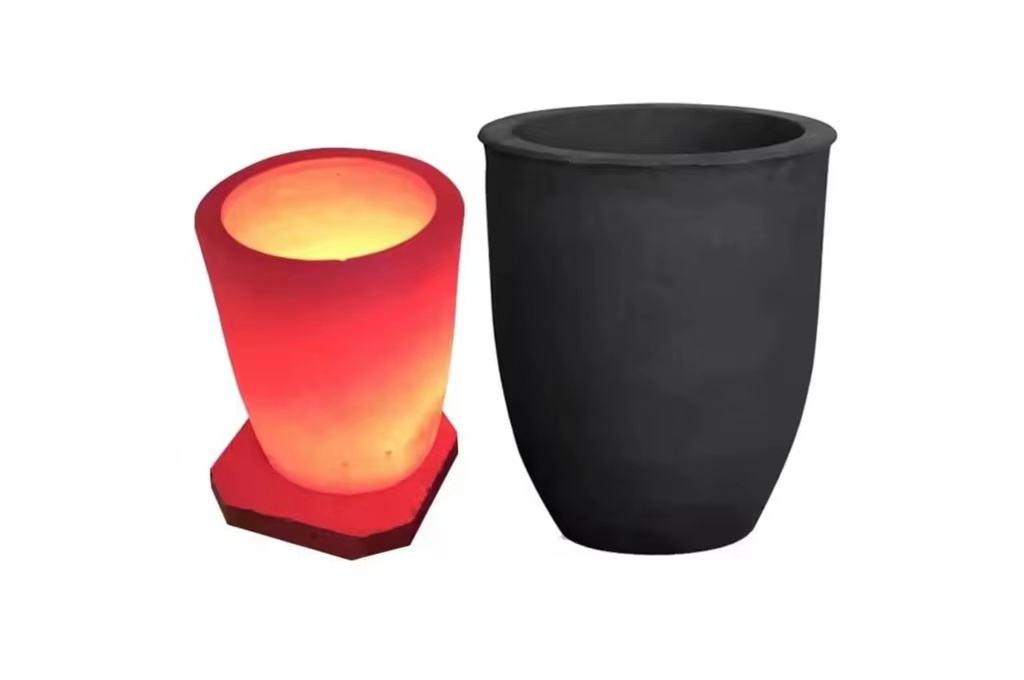Le creuset en graphite est un récipient de fusion pour les réactions à haute température. Il est fabriqué en graphite et présente une bonne résistance à la chaleur et à la corrosion. Il est largement utilisé en chimie, en métallurgie, en verrerie et dans d'autres domaines. Il permet notamment de fondre des métaux non ferreux et des alliages tels que le cuivre, l'or, l'argent, le zinc, etc.
Table des matières
ToggleLe processus de production
Sélection des matériaux :
Le matériau utilisé pour fabriquer le creuset en graphite doit être du graphite naturel ou artificiel de haute pureté et de haute cristallinité. La teneur en carbone du graphite doit être supérieure à 99% et la teneur en impuretés doit être inférieure à 0,2% afin de garantir la qualité et les performances du produit.
Frittage physique :
Le creuset en graphite est fabriqué par frittage physique. Tout d'abord, la poudre de graphite est criblée pour éliminer les impuretés et les particules de graphite irrégulières. Ensuite, le poudre de graphite est pressé en forme de creuset et fritté à haute température pour former une structure solide de graphite.
Usinage de précision :
Le creuset en graphite fritté est usiné avec précision. Il comprend la finition de l'aspect, la correction de la taille, le traitement de la surface et d'autres processus. Grâce à l'usinage et au polissage, il présente un aspect lisse, une taille précise et est facile à appliquer et à utiliser.
Inspection et contrôle de la qualité :
Il s'agit notamment de l'inspection de la composition des matériaux, de l'inspection de l'uniformité du frittage, de l'inspection de la précision des dimensions, etc. Parallèlement, des tests de stabilité chimique et de résistance aux températures élevées sont également nécessaires pour garantir la stabilité et la fiabilité du produit dans les réactions à haute température.
Contrôle du processus de frittage :
Nous devons contrôler la température et la durée du frittage afin de garantir que la structure cristalline du graphite est correctement modifiée pour former une structure dure. Parallèlement, au cours du processus de frittage, il convient également de veiller à empêcher la déformation et la fissuration du creuset en graphite et de prendre les mesures appropriées pour garantir la qualité du produit.
Graphitisation :
Le creuset est mis sous tension à haute température et sans oxygène pour le traitement de graphitisation afin de le convertir en une structure de graphite stable.
Traitement de surface :
Il s'agit d'améliorer sa résistance à la corrosion et sa stabilité chimique. Les méthodes courantes de traitement de surface sont l'imprégnation et le revêtement. La méthode d'imprégnation consiste à immerger le creuset en graphite dans un liquide spécifique pour former une couche protectrice. revêtement La méthode de revêtement consiste à appliquer le matériau de revêtement sur la surface du produit pour former une couche protectrice.
Emballage et stockage :
Une fois terminé, il doit être emballé et stocké afin d'éviter toute détérioration ou contamination du produit. Les méthodes d'emballage les plus courantes sont le film plastique, la mousse de protection, etc. Pendant le stockage, il faut éviter tout contact avec l'humidité et les produits chimiques, et garder le produit sec et propre.
Exigences techniques du creuset en graphite
La température de travail du creuset en graphite est généralement supérieure à 1000℃, et le maximum est supérieur à 3000℃. Parmi eux, la température de cuisson est l'un des facteurs clés affectant la qualité du creuset. Plus la température de cuisson est élevée, plus sa densité, sa solidité et sa résistance à la corrosion sont importantes. Mais elle aura aussi un impact plus important sur son prix.
Conclusion :
Le processus de production et les exigences techniques des creusets en graphite comprennent la sélection des matériaux, le frittage physique, l'usinage de précision, les essais et le contrôle de la qualité, le contrôle du processus de frittage, le traitement de surface, l'emballage et le stockage. Ce n'est donc qu'en contrôlant strictement la qualité et les conditions de traitement de chaque maillon que nous pouvons produire des creusets en graphite aux performances supérieures et à la qualité stable.

